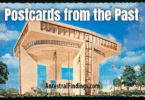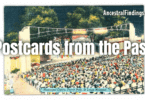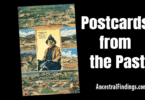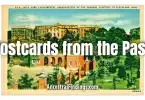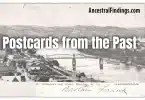I’m holding a postcard today that feels different from most of the others in my collection. It doesn’t show a grand hotel, a busy beach, or a flashy tourist attraction. No, this one shows something quieter—two hand-built huts sitting in the dirt beneath a wide Texas sky.
They’re simple. The one on the left looks to be made of thick mud with a thick palm-thatched roof. The one on the right? A little taller and more open, woven from sticks and palm fronds. Between them, a crooked tree leans toward the camera, its branches rustling above a bench made from a rough-cut board. There’s no pavement, no electricity, no cars. Just silence.
The caption on the back reads:
“Palm leaves, mud and branches of trees are about all that are necessary to build La Chozas (The Huts). These homes are now very rare and are known to withstand severe storms and rains.”
That line stayed with me: “These homes are now very rare.”
Looking Closer at the Card
There’s something about this image that stops me. It’s not dramatic, but it’s alive. You can feel the warmth of the sun on the earth. You can almost hear the wind rattling the palm leaves. And it makes you wonder—who lived here?
The postcard was published by Dan Bartels in McAllen, Texas, and it’s most likely a real photograph of a once-common homestead along the borderlands of Texas and Northern Mexico. “La Choza” is a Spanish term, simply meaning “hut,” but there’s nothing dismissive about it. In this context, it represents an entire tradition of handmade homes built from whatever the land would give.
These huts were cool in the Texas heat. Their thick, organic walls kept the air inside from baking. Their roofs shed water like a duck’s back. They didn’t require blueprints or building codes—just skill, memory, and maybe a little community help.
A Style Rooted in Survival
I did a little digging after looking at this card, just trying to trace the story behind it. Turns out these huts weren’t just quaint throwbacks—they were lifelines.
Families across South Texas and Northern Mexico built La Chozas for generations. These homes were born out of necessity. Palm fronds were abundant. Trees offered straight branches. Mud held it all together. No lumberyards. No cement trucks. Just hands, tradition, and a kind of rugged resourcefulness you don’t see as often anymore.
They were designed with storms in mind—built low, strong, and able to sway slightly rather than shatter. In many cases, they held up better than tin-roofed shacks or hastily built cabins. It’s ironic, in a way, that the materials people once looked down on—mud and palm—ended up offering the most lasting protection.
What We Lose When the World Modernizes
The postcard notes that these homes are now very rare. I couldn’t find many examples still standing today—at least not original ones still used as homes.
Some were torn down when regulations changed. Others were left behind when families moved on or were encouraged to adopt more “modern” housing. Over time, La Chozas started disappearing from the landscape. They weren’t considered worth saving.
But this postcard preserves a tiny slice of that world. It reminds me that architecture isn’t always about monuments and cities. Sometimes it’s about a patch of dirt, a roof that doesn’t leak, and a life lived close to the land.
My Reaction as a Collector
This card hit me differently than most. It made me pause. A lot of my collection features colorful hotels, old highways, railcars, and beaches. But this one—the stillness, the handmade beauty—it reminded me why I started collecting postcards in the first place.
It’s like holding a small window into the past. Not the polished kind we find in history books, but the lived-in kind. The kind you might have passed by without noticing if you didn’t stop and look.
I don’t know exactly where this photo was taken, and I may never find out. But part of me hopes these huts are still there, still standing in the sun somewhere in South Texas. And if they’re not, I’m glad this card exists to remind us they once were.
Closing Thoughts
This is why I started Postcards from the Past. I wanted to take time with the ones that felt personal—the ones that asked more of me than just a passing glance. I don’t write about every card I own. But every now and then, one of them jumps out of the pile and says, “Sit with me a while.”
If you’re enjoying these, let me know. I’ve got many more waiting to be rediscovered—each one holding a quiet story of a place, a time, and the people who made it home.
And if you’d like to send me a postcard of your own, I’d love to see it. I collect postcards from all over the world. Just click on “Contact.” I’ll send you my mailing address. I always look forward to seeing what arrives in the mail.
Until next time—
Will

